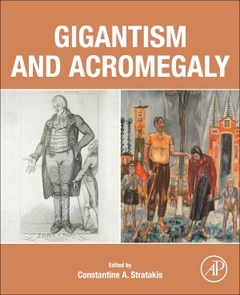Gigantism and Acromegaly Genetics, Diagnosis, and Treatment
Coordonnateur : Stratakis Constantine A.

Gigantism and Acromegaly brings together pituitary experts, taking readers from bench research, to genetic analysis, clinical analysis, and new therapeutic approaches. This book serves as a reference for growth hormone over-secretion and its diagnosis and treatment for endocrinologists, pediatricians, internists, and neurosurgeons, and for geneticists. Pharmaceutical companies may use it as a reference for drug development and research. Students, residents and fellows in medicine and endocrinology and genetics will also find it valuable as it provides a single up-to-date review of the molecular biology of gigantism and acromegaly as well as recommended approaches to evaluation and management.
Acromegaly is a rare pituitary disorder that slowly changes its adult victim?s appearance over time: larger hands and feet, bigger jaw, forehead, nose, and lips. Generally, a benign pituitary tumor is the cause and symptoms of acromegaly can vary from patient to patient, making a diagnosis difficult and prolonging suffering for years. Early detection is key in the management of acromegaly as the pathologic effects of increased growth hormone (GH) production are progressive and can be life-threatening as the result of associated cardiovascular, cerebrovascular, and respiratory disorders and malignancies.
1. History of the identification of gigantism and acromegaly Liliya Rostomyan, Albert Beckers and Patrick Petrossians 2. Pathology of pituitary growth hormone excess Sylvia L. Asa and Shereen Ezzat 3. Gigantism: clinical diagnosis and description, Iulia Potorac Liliya Rostomyan, Adrian F. Daly, Patrick Petrossians and Albert Beckers 4. Acromegaly: clinical description and diagnosis Kevin C.J. Yuen and Albert Becker 5. GPR101, an orphan G-protein coupled receptor, with roles in growth, puberty, and possibly appetite regulation Fady Hannah-Shmouni and Constantine A. Stratakis 6. The role of the aryl hydrocarbon receptor interacting protein in pituitary tumorigenesisLaura C. Herna´ndez-Rami´rez 7. The 3PAs syndrome and succinate dehydrogenase deficiency in pituitary tumors Paraskevi Xekouki, Vasiliki Daraki, Grigoria Betsi, Maria Chrysoulaki, Maria Sfakiotaki, Maria Mytilinaiou and Constantine A. Stratakis 8. CDKN1B (p27) defects leading to pituitary tumors Sebastian Gulde and Natalia S. Pellegata 9. Multiple endocrine neoplasia syndromes and somatotroph adenomas Carolina R.C. Pieterman and Steven G. Waguespack 10. GNAS, McCune
Endocrinologists with interest in pituitary tumors resulting in acromegaly and gigantism, pediatric endocrinologists and clinical geneticists, medical students and fellows.
Dr. Stratakis identified the genes for Carney complex and Carney-Stratakis syndrome, and other genetic defects leading to adrenal and other tumors, and he and his laboratory have published extensively in the fields of pediatric inherited disorders and cancer genetics, and on other pediatric adrenal and pituitary disorders. He is the author of more than 300 publications and has served as a regular reviewer. He is the author or co-author of nearly 600 publications, and has served as a regular reviewer for more than 100 journals, including Science, Nature Genetics, and the New England Journal of Medicine; he is currently Deputy Editor of the Journal of Clinical Endocrinology & Metabolism, the leading journal in Endocrinology. He has been the recipient of the 1999 Pharmacia-Endocrine Society Award for Excellence in Published Clinical Research, and NIH Merit Awards, and named Visiting Professor in academic centers around the world. In 2009, he was awarded the Ernst Oppenheimer Award of the Endocri
- Accessible, up-to-date overview of the characteristics, state-of-the-art diagnostic procedures, and management of acromegaly and gigantism
- Provides a unique compendium of endocrinology, genetics, clinical diagnosis and therapeutics
- Contains contributions from internationally known experts who have treated patients with acromegaly and gigantism
Date de parution : 06-2021
Ouvrage de 310 p.
19x23.3 cm
Thèmes de Gigantism and Acromegaly :
Mots-clés :
3PAs; AIP; Acromegaly; Adenoma; Adjuvant therapy; CDKN1B; Clinical features; Clinical manifestations; Cyclic AMP; Diagnosis; Ectopic hormone production; Epidemiology; Eutopic hormone production; FIPA; Familial isolated pituitary adenoma; GH; GH-producing tumors; GNAS; GPR101; Genetic screening; Gigantism; Growth hormone; Growth hormone (GH); Growth hormone–releasing hormone (GHRH); Gsa; Hyperplasia; Hypothalamus; Intraoperative MRI; MEN1; MEN2; MEN4; McCune–Albright syndrome; NF1; Neuroendocrine tumor; Outcomes; P27; Paraganglioma; Pathophysiology; Pegvisomant; Pheochromocytoma; Pituitary; Pituitary adenoma; Pituitary neuroendocrine tumors; Pituitary pathology; Pituitary tumors; Protein kinase A; Pseudoacromegaly; Signs; Somatostatin analog; Somatotropinoma; Succinate dehydrogenase; Symptoms; TSS; Transsphenoidal surgery; Treatment; X-LAG



